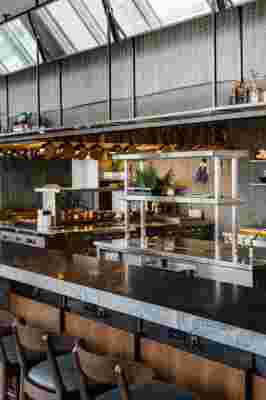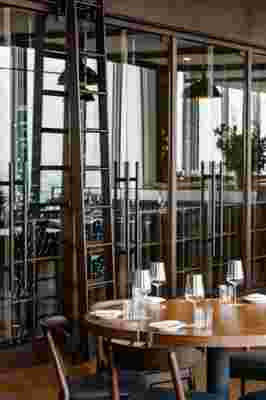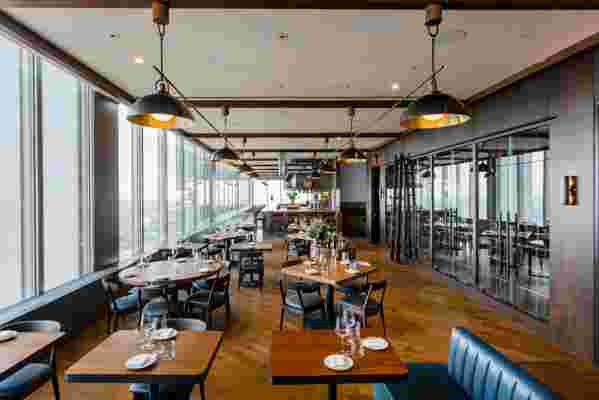Whenever world-renowned restaurateur Danny Meyer walks into someone else’s dining establishment, he takes immediate note of how the place affects his mood. "Even before I’m ooh-ing and aah-ing at the light fixtures and the bar, the tabletop design, all the decisions that most restaurateurs labor over, I’m just asking myself how I feel, " Meyer says. "You either feel good or you don’t—you can tell within a second." It’s that keen ability to read and riff on the elements of winning restaurants that the hospitality mogul has again demonstrated with the newest addition to his empire, Manhatta.
Meyer has made a name for himself by bringing an alchemic mix of exceptional food, exceedingly gracious staff, and finely tuned atmosphere to a number of unexpected locations: Citi Field, Madison Square Park, JFK airport, the Saratoga racetrack. So when an opportunity arose to open a 30,000-square-foot restaurant and bar (Manhatta) and private-event space (the Bay Room) on the 60th floor of 28 Liberty Street, the iconic Skidmore, Owings & Merrill–designed tower in Downtown Manhattan, Meyer didn’t balk. The author of industry bible Setting the Table and founder of Union Square Hospitality Group, Meyer says the unfortunate tendency for "high-altitude" eateries at the top of skyscrapers is to make them too formal, such that the space and service compete with the dramatic panorama.

"There is no question that very few of us have this kind of a view out our window at home," says Meyer of the restaurant's spectacular vistas. "So putting in an open kitchen that almost feels like a domestic kitchen was important as a counterbalance."

Manhatta boasts an extensive wine program with several hundred labels, some 2,000 bottles of which are stored in plain view of diners, in a working cellar behind a wall of glass.
To be sure, the views at Manhatta (whose name was inspired by the Walt Whitman poem "Manahatta," his ode to New York City) are magnificent, but they're just one ingredient in a complex recipe. Guests arrive via private elevators from a separate lobby at street level, near the 1961 International Style building's famous plaza, which is anchored by Jean Dubuffet's black-and-white sculpture Group of Four Trees. Upon entering the restaurant, one is greeted by a 40-foot walnut-and-granite bar in front of a wall of windows facing east over the tops of neighboring towers, the East River, and Brooklyn beyond. It's a distinct vantage that Meyer knew was special on his very first visit. "It feels like a gift to have lived in this city for over 30 years and to have a fresh perspective on my home for the first time," he says, "and I love that the back bar is Manhattan rather than a bunch of bottles of booze."
I didn’t go up to the 60th floor to pray—I went to have fun.
Instead of trying to compete with the spectacular setting with fussy gimmicks like flaming baked Alaska and silver prime-rib trolleys, Meyer and his design team, led by Wade Little of the firm Woods Bagot, set about utilizing markedly cozy domestic elements. "I didn’t go up to the 60th floor to pray—I went to have fun," says Meyer, who likes to blur the line between going out and coming home in all of his restaurants, which include the acclaimed Union Square Café, Gramercy Tavern, Blue Smoke, the Modern, and Shake Shack. "When we entertain in our homes, we spend most of our time in or around the kitchen." (Manhatta's menu, with its inventive, unfussy new American dishes, equally echoes this welcoming mood.)

"There could have been no bar, but there was an opportunity to give our guests the chance to walk through a party before they get to the restaurant," says Meyer, "so that they get the cue right off the bat that you can just relax and have fun."
Accordingly, Little and his colleagues knew the kitchen needed to be open and centrally located to achieve the buzzy, warm, and relaxed ambience of a dinner party in someone’s house. "The heart and hearth of the restaurant, the kitchen, is open on all sides so every diner can experience it," explains Little of the subway-tiled central workspace, which will be helmed by executive chef Jason Pfeifer (who spent six years overseeing the kitchen at another Meyer restaurant, Maialino, at the Gramercy Park Hotel). "Manhatta rejects glitz in favor of enduring materials in tones of honey, coffee, and deep aquamarine," adds Little. Indeed, leather and walnut, granite and silk, brass and bronze comprise Manhatta’s rich material palette. The design team didn’t completely ignore the building’s midcentury glamor, either, incorporating 1960s lines in the walnut tables and chairs. The decision-making process was measured and deliberate: Arc pendant lights are perforated bronze, so as to minimize reflections on the picture windows after sunset. Little and his team collaborated with Meyer to select the artwork throughout, which includes more than 100 original paintings from the Artists’ Pension Trust, a foundation that supports emerging artists.
The key visual takeaway here, as with all Meyer establishments, is meant to be one of individuality and low-key revelry. "I’ve spent my entire life wishing I had the talent to be a musician, and if I were a musician, I’d look at every new restaurant as if it were a song," comments Meyer. "Any one note on its own may not sound like much—but when you put them all together, it should sound fresh." Manhatta opens for dinner on Tuesday, July 17.
RELATED: Eleven Madison Park Reopens with a Swanky New Look
